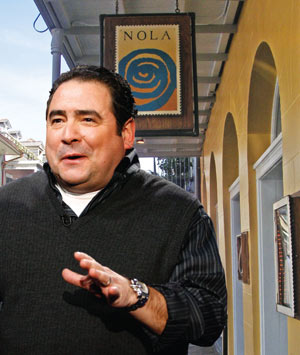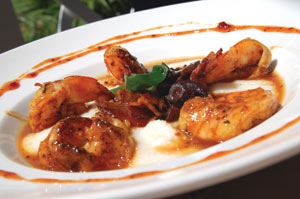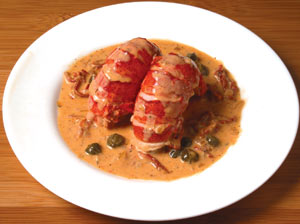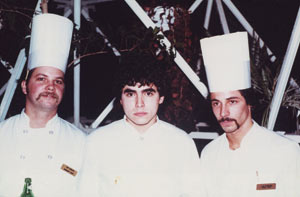Summerguide 2010
Emeril Lagasse–one of us? Ayuh, it’s true–and he’s not alone. Louisiana’s best Cajun chefs have Acadia in their roots–and on
their plates.
By Robert Witkowski
 Emeril Lagasse doesn’t just fill the doorway of his St. Louis Street restaurant, NOLA, in the French Quarter of New Orleans–he’s also standing at the very threshold of the place in contemporary cuisine where Acadia meets Cajun.
Emeril Lagasse doesn’t just fill the doorway of his St. Louis Street restaurant, NOLA, in the French Quarter of New Orleans–he’s also standing at the very threshold of the place in contemporary cuisine where Acadia meets Cajun.
And there it is–“BAM!”–the realization that the very word Cajun derives from Acadian, as in the 18th-century French colonists romanticized in Longfellow’s epic poem, Evangeline, who were forced by the British to leave this neck of the woods as exiles during “Le Grand Dérangement.” Many of them settled in the New Orleans area.
Get where we’re going with this? The internationally celebrated Cajun cuisine that pan-blackened the 1980s and continues to add zest to the 21st century traces its roots directly to, well, us (not like we’re trying to take credit for it or anything).
Emeril even touts his restaurants’ sensational offerings as “true Acadian [remember Acadia National Park?] cuisine–a more refined ‘city version’ of the rustic Acadian cooking found in the rural settlements in Louisiana,” and before that, Maine and Atlantic Canada.
Born in Massachusetts and a former head chef at Sheraton Inn’s Seasons restaurant across the street from the Maine Mall in South Portland, Emeril channels New England whenever he cooks his favorite variation on Maine lobster, deftly mingling it with Cajun flair and another richly flavored tale of immigration from our shores. As he tells us:
“[Although my father’s heritage is French-Canadian], Piri Piri Pasta’s a dish I created in honor of my mom, Hilda, who is a great cook. She was the first person to show me how to cook at a young age. She grew up in a Portuguese family and loves the spicy piri piri sauce. This dish was created for my restaurant…We use live Maine lobster and make our own fresh pasta…talk about a marriage made in heaven!”
BLACKENED MAGIC
If you’re talking about the place where Acadian meets Cajun, Paul Prudhomme knows “where you at.” His family’s from up here, too, where he visits with kin at “family reunions every five years or so.” Here, the family enjoys its Acadian-Cajun heritage, and in his stomping grounds in New Orleans, Prudhomme is understanding of and sensitive to the inclusive nature of the Acadian migration to Louisiana, both in food and people. “The Acadian attitude is all about marrying [new] cultures in our family–it’s a huge gumbo.”
As Prudhomme–the man who invented pan-blackening–tells me this, he is holding court on Chartres Street at K-Paul when coincidentally a couple from Quebec walks in and tries to catch his eye. Prudhomme tosses a quick glance my way and grins, because everyone this side of Bourbon Street knows it’s a reenactment of the original flight of the French from northern Maine and maritime Canada to New Orleans in 1755. Maybe that’s why there’s an enormous oak tree in Cajun Country named Evangeline.
But is the Acadian-Cajun connection still vibrant and influential? Prudhomme says, “There’s a huge amount of travel of people from Canada coming here to visit and going north to visit there. Something that happened 180- to-200 years ago–to keep that alive you have to be into it, and work at it, and keep at it.” He motions toward a steaming plate of slow-roasted chicken with shrimp-corn-bread dressing and cheddar-cheese sauce. ”I think food is passed on to every generation, and that’s how it should be.”
Asked for “ghost” Acadian ingredients in his Cajun cuisine, Prudhomme laughs. “Ain’t no ‘cuisine’ here–we serve food! Good food! It’s always evolving.” There’s a sly smile. “I’m a Cajun, and we know we’re not food. My food is Louisiana food. It’s the best food in the world. Nothing is essential. We got a lot of dirt here, man, and at least ten months to [grow in] it. We always have something to cook.”
CREATURE FROM THE BLACKENED LAGOON
Born in a swamp outside Opelousas, Prudhomme talks with pride about how his “mother’s side of the family came from Acadia” during the 18th-century expulsion. It was at his mother’s skirt that he and his siblings learned to cook. “We come from a family that cooks, no doubt about that!”
As for where the magic comes from, “[It’s] just working. My first four restaurants failed. It was a lesson incredibly easy to understand. Then, my experience [as chef at Commander’s Palace in the Garden District] from [owner] Ella [Brennan] talking about making a buck–I learned more from her than anyone else.” He eventually decided to follow his own lucky star, which inspired him to leave Opelousas and bring with him “the andouille, the tasso, [and] the spicy-spiciness of the Cajuns,” according to local food guru Poppy Tooker, adapting his magic potions to “classic Creole recipes.” Then the movie stars and food channels started calling.
Not that Emeril, who was once Prudhomme’s James Beard Award-winning protégé, hasn’t put his spin on things. “I’m not knocking Prudhomme,” Lagasse told Nation’s Restaurant News a year before opening Emeril’s in New Orleans in 1990. “Our philosophies are just different.”
 ALL ABOUT EVE
ALL ABOUT EVE
And so we are brought full circle to Old Orchard Beach-native Michael Ruoss, who impulsively moved to New Orleans and became Emeril’s star pupil and chef de cuisine at NOLA after graduating from Southern Maine Technical College’s culinary program. Now that’s an advertising success story for a famous SMTC graduate!
“I worked for Emeril for eleven years before opening this new restaurant, Catch, with Emeril’s blessing.”
So how does a Maine-born and trained chef see the evolution of French cuisine from the other side of the looking glass?
“The bridge between the food in Maine and Louisiana is the Canadian-French culture.” Ruoss goes quiet, thinking, “The low…slow…braising of proteins, creating the homemade sauces, charcuterie (the art of curing meats and making sausages to preserve over long periods of time)–the techniques are all classic French cooking. What defines the difference is what we call down here the ‘Holy Trinity’: green bell peppers, onions, and celery. These are the standard in every Cajun dish. Also, you have potatoes up north and we have rice fields.” (As for the “Holy Trinity,” we couldn’t help but notice if you substitute carrots for the peppers, you have a classic French mirepoix, which is used widely across Maine as the base for soups and stocks.)
“Chicken fricassee and chicken etouffee,” Ruoss ventures as a perfect example of the dishes evolved and shared between the two cultures. “They’re the same thing! Smothered chicken, and they’re both yummy.”
So is there really a difference? “Aside from the spicy factor, if Louisiana had potatoes instead of rice and no bell peppers, it’s a fair assumption that the food would not be very different.” Ruoss says.
But it is different. And the heat comes from more than just the peppers in this evolved culture.
“I like the culture down here in New Orleans,” Ruoss says with a broad smile. “Like Portland, it’s got its own kind of vibe.”
Asked about how the current oil spill is affecting restaurant offerings in New Orleans, Ruoss says, “It’ll take a couple years before we know the damage. Shrimp are lost and won’t reproduce. As they close down fishing areas, they get more expensive. We changed the menu. Prices are up 10%. We can eat some of [the increase], but not all of it. The biggest hit is oysters–we’re not flying in oysters from anywhere else! We’ll still get everything locally…until we can’t.”
As for watching Emeril become world-famous, he rolls his eyes and laughs. “Yeah, I noticed around the time he got married. National Inquirer reporters were following and asking me where he was getting married! ‘Give you $100 if you tell me where he’s getting married.’ I was, like, ‘No, he’s my boss!’ Plus, the corporate office issued press statements on what to say to the press for employees. I think that’s when it hit me.”
Now Ruoss is chatting it up with other celebrity chefs as his own star begins to soar. “I plated up for Lydia Shire [owner of Blue Sky on York Beach] at Carnivale du Vin which raises millions for the Emeril Lagasse Foundation.” He deadpans, Maine-style, “And I got a kiss form Alice Waters [legendary chef/owner of Chez Panisse, a training ground for Primo’s Melissa Kelly]. Alice inspired me as a young cook.”
What? No home sickness? No cravings from the North?
“Steamers! You can’t get clams down here! Clam cakes–nothing, and I still need to have Moxie mailed to me. My friend Ed Greenleaf flew down just for the weekend from Biddeford to pay off his Superbowl bet–one dollar and two cases of Moxie!” he says proudly, which can only mean he is a Saints fan.
Sadly, he didn’t bring the antidote for Moxie (which, in our opinion, is a palette-numbing absinthe chaser).
Another aspect Ruoss has brought to Catch is a deep reverence for Maine’s fishing industry. “I have farm-raised salmon flown in from Maine every week, and we have Maine foods on the menu–shepherd’s pie–and I bet we’re the only restaurant in New Orleans that has oyster crackers. It’s a little slice of Maine on Magazine Street.”
 King Creole, Meet King Lobster
King Creole, Meet King Lobster
Lobster has always had a place in Ruoss’s heart. “We’ve gotten Maine-bought lobster as a special. I had lobster flown down from Commercial Street for New Year’s Eve at NOLA.”
And how do the Cajuns cover for their indebtedness to Maine?
“Legend has that lobsters missed the French and followed them to Louisiana, and the journey shrunk them to crawfish,” Ruoss says.
Oh. So basically they can be prepared in the same way, as in crawfish thermedor?
”Noooo, you can’t do that!” Ruoss cries, agape in horror. “Crawfish have their own taste–you…you just can’t do that.”
Now Prudhomme jumps in, vigorously shaking his head. “Those crawfish been in the mud a long time, but you can do anything the same. Don’t matter.”
Yet while northerner Ruoss defends the individual integrity of southern crawfish, Prudhomme’s respect for Maine lobster is reverential as he leans over, astonished at the concept of a lobster roll. “A roll? I don’t think I’d do that! Lobster is very special–perfect the way it is. Why change it?”
While Prudhomme’s memories of Maine are dominated by blueberry fields and unpleasant recollections of the cold, Ruoss is positively giddy at spending part of this summer with us, if possible.
“I go all over! Red’s Eats…my favorite is Fore Street–Sam Hayward does an excellent job!” (Imagine if Emeril had received such enthusiastic applause when he was here.) Ruoss continues, “Rapid Rays in Biddeford–it’s great! So much salt on everything. There’s a hamburger called The Big One.”
Ruoss’s biggest high so far happened when Presidents Bill Clinton and George H. W. Bush strolled into NOLA after Hurricane Katrina and received a standing ovation. Ruoss smiles at the memory of President Bush meeting him after a meal of smoked duck and laughing, “‘I can’t wait to tell Barbara I came all the way to New Orleans [from Maine] to have duck!’”
Asked how he might cater to Longfellow’s fictional heroine, Evangeline, should she be able to walk through K-Paul’s doors today, Prudhomme–her Cajun kin–quips, “Feed her whatever I had!” He opens his arms as if to greet her. “It’s the idea of freshness. We have no freezers. We serve whatever we have that day.”
Before he was Emeril, he was one of us!
 When he said, ‘BAM!‘ I said, ‘Oh, God! That’s Emeril!’” laughs Fern Genest, 76, remembering the first time she saw Emeril John Lagasse III on television. “It was his mannerisms in the kitchen. Something was always going on.”
When he said, ‘BAM!‘ I said, ‘Oh, God! That’s Emeril!’” laughs Fern Genest, 76, remembering the first time she saw Emeril John Lagasse III on television. “It was his mannerisms in the kitchen. Something was always going on.”
He was no longer the slim 21-year-old who came into her employ by landing a job at a hotel near the Portland Jetport, back when he was beneath the radar of celebrity and far from the glaring spotlight of fame–back when he was one of us. He was now Emeril®.
“I inherited him when [Dunfey Hotels] sent Emeril to us in late 1980. He had been sous chef at the Parker House in Boston,” says Genest, former general manager of the South Portland Sheraton Inn (currently Wyndham Portland Airport Hotel). “[His arrival] didn’t get nearly the fanfare he deserved. He came when we changed the restaurant to Seasons–he was part of that change. The menu had a lot of seafood creations, and in Maine, people expected heavy seafood.”
The May 1981 issue of Business Digest chimed in with stock hyperbole: “The restaurant and lounge have a new look, new menu, and new name…new executive chef Emeril Lagasse has created a menu of traditional cuisine with seasonal specialties…Seasons, which will reflect the seasons of New England, will be a hit here.”
“He was very low key, very serious about cooking, but fun–he liked to joke around. The staff loved him.” Approaching the kitchen, “I’d always hear all this noise–and then I’d walk in and it was like, ‘Mom’s home!’ It would go quiet; everything stopped.”
Genest also saw Emeril’s innovations raise the culinary experience at the Sheraton in the finest details. “It was his idea to take color pictures of the [finished] dishes and hang them in the kitchen so everyone knew what they needed to look like. If every [detail] didn’t look like the picture, it wasn’t done correctly–it was wrong, and they needed to do it again.”
“It was his first executive chef position. He was very creative but limited by corporate structure–I call it corporate interference. Everything he suggested had to be approved through our food-and-beverage guidelines. I don’t think he had a lot of control.”
With his wife, Elizabeth, Emeril began raising his family in Portland. Genest remembers, “He went on about his new baby girl! But, he was serious about his job, putting in long hours–he was there all the time.”
After her transfer, Genest tried to contact her talented chef and was told, “He’s left and gone to work for Prudhomme [at Commander’s Palace in New Orleans].” Years later, Genest’s daughter Denise, who’d also known Lagasse, insisted her mother watch a new cooking show. “I said, ‘I’ll be damned, there he is!’ It’s my granddaughter’s favorite show!”
“He was a pistol! I was amazed but not surprised [he became famous]–he had that ‘go for it.’ It was the passion he had for cooking,” Genest says with an almost maternal pride. “I am very proud of him, but he’s put on too much weight. Naughty, naughty.”





0 Comments
Trackbacks/Pingbacks